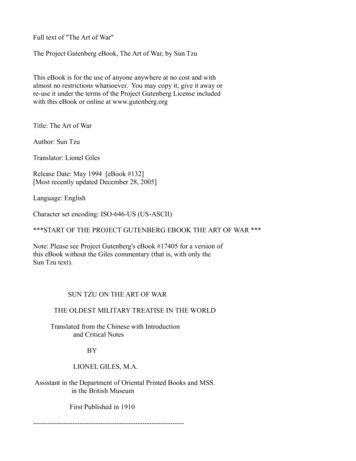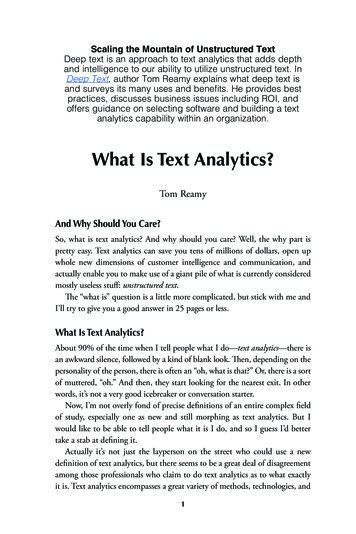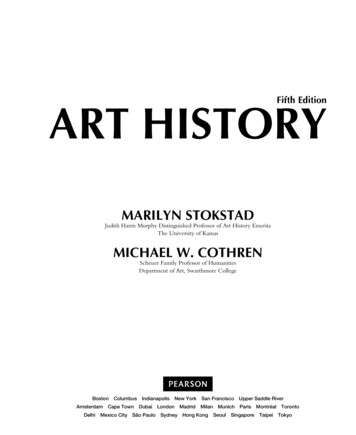
Transcription
Full text of "The Art of War"The Project Gutenberg eBook, The Art of War, by Sun TzuThis eBook is for the use of anyone anywhere at no cost and withalmost no restrictions whatsoever. You may copy it, give it away orre-use it under the terms of the Project Gutenberg License includedwith this eBook or online at www.gutenberg.orgTitle: The Art of WarAuthor: Sun TzuTranslator: Lionel GilesRelease Date: May 1994 [eBook #132][Most recently updated December 28, 2005]Language: EnglishCharacter set encoding: ISO-646-US (US-ASCII)***START OF THE PROJECT GUTENBERG EBOOK THE ART OF WAR ***Note: Please see Project Gutenberg's eBook #17405 for a version ofthis eBook without the Giles commentary (that is, with only theSun Tzu text).SUN TZU ON THE ART OF WARTHE OLDEST MILITARY TREATISE IN THE WORLDTranslated from the Chinese with Introductionand Critical NotesBYLIONEL GILES, M.A.Assistant in the Department of Oriental Printed Books and MSS.in the British MuseumFirst Published in -------------------
To my brotherCaptain Valentine Giles, R.G.in the hope thata work 2400 years oldmay yet contain lessons worth considerationby the soldier of todaythis translationis affectionately ------------------------Preface to the Project Gutenburg Etext-------------------------------------When Lionel Giles began his translation of Sun Tzu's ART OFWAR, the work was virtually unknown in Europe. Its introductionto Europe began in 1782 when a French Jesuit Father living inChina, Joseph Amiot, acquired a copy of it, and translated itinto French. It was not a good translation because, according toDr. Giles, "[I]t contains a great deal that Sun Tzu did notwrite, and very little indeed of what he did."The first translation into English was published in 1905 inTokyo by Capt. E. F. Calthrop, R.F.A. However, this translationis, in the words of Dr. Giles, "excessively bad." He goesfurther in this criticism: "It is not merely a question ofdownright blunders, from which none can hope to be wholly exempt.Omissions were frequent; hard passages were willfully distortedor slurred over. Such offenses are less pardonable. They wouldnot be tolerated in any edition of a Latin or Greek classic, anda similar standard of honesty ought to be insisted upon intranslations from Chinese." In 1908 a new edition of Capt.Calthrop's translation was published in London. It was animprovement on the first -- omissions filled up and numerousmistakes corrected -- but new errors were created in the process.Dr. Giles, in justifying his translation, wrote: "It was notundertaken out of any inflated estimate of my own powers; but Icould not help feeling that Sun Tzu deserved a better fate thanhad befallen him, and I knew that, at any rate, I could hardlyfail to improve on the work of my predecessors."Clearly, Dr. Giles' work established much of the groundworkfor the work of later translators who published their owneditions. Of the later editions of the ART OF WAR I haveexamined; two feature Giles' edited translation and notes, theother two present the same basic information from the ancientChinese commentators found in the Giles edition. Of these four,Giles' 1910 edition is the most scholarly and presents the readeran incredible amount of information concerning Sun Tzu's text,much more than any other translation.
The Giles' edition of the ART OF WAR, as stated above, was ascholarly work. Dr. Giles was a leading sinologue at the timeand an assistant in the Department of Oriental Printed Books andManuscripts in the British Museum. Apparently he wanted toproduce a definitive edition, superior to anything else thatexisted and perhaps something that would become a standardtranslation. It was the best translation available for 50 years.But apparently there was not much interest in Sun Tzu in Englishspeaking countries since it took the start of the SecondWorld War to renew interest in his work. Several peoplepublished unsatisfactory English translations of Sun Tzu. In1944, Dr. Giles' translation was edited and published in theUnited States in a series of military science books. But itwasn't until 1963 that a good English translation (by Samuel B.Griffith and still in print) was published that was an equal toGiles' translation. While this translation is more lucid thanDr. Giles' translation, it lacks his copious notes that make hisso interesting.Dr. Giles produced a work primarily intended for scholars ofthe Chinese civilization and language. It contains the Chinesetext of Sun Tzu, the English translation, and voluminous notesalong with numerous footnotes. Unfortunately, some of his notesand footnotes contain Chinese characters; some are completelyChinese. Thus, a conversion to a Latin alphabet etext wasdifficult. I did the conversion in complete ignorance of Chinese(except for what I learned while doing the conversion). Thus, Ifaced the difficult task of paraphrasing it while retaining asmuch of the important text as I could. Every paraphraserepresents a loss; thus I did what I could to retain as much ofthe text as possible. Because the 1910 text contains a Chineseconcordance, I was able to transliterate proper names, books, andthe like at the risk of making the text more obscure. However,the text, on the whole, is quite satisfactory for the casualreader, a transformation made possible by conversion to an etext.However, I come away from this task with the feeling of lossbecause I know that someone with a background in Chinese can do abetter job than I did; any such attempt would be welcomed.Bob ----------------INTRODUCTIONSun Wu and his Book-------------------
Ssu-ma Ch ien gives the following biography of Sun Tzu: [1]-Sun Tzu Wu was a native of the Ch i State. His ART OFWAR brought him to the notice of Ho Lu, [2] King of Wu. HoLu said to him: "I have carefully perused your 13 chapters.May I submit your theory of managing soldiers to a slighttest?"Sun Tzu replied: "You may."Ho Lu asked: "May the test be applied to women?"The answer was again in the affirmative, so arrangementswere made to bring 180 ladies out of the Palace. Sun Tzudivided them into two companies, and placed one of the King'sfavorite concubines at the head of each. He then bade themall take spears in their hands, and addressed them thus: "Ipresume you know the difference between front and back, righthand and left hand?"The girls replied: Yes.Sun Tzu went on: "When I say "Eyes front," you mustlook straight ahead. When I say "Left turn," you must facetowards your left hand. When I say "Right turn," you mustface towards your right hand. When I say "About turn," youmust face right round towards your back."Again the girls assented. The words of command havingbeen thus explained, he set up the halberds and battle-axesin order to begin the drill. Then, to the sound of drums, hegave the order "Right turn." But the girls only burst outlaughing. Sun Tzu said: "If words of command are not clearand distinct, if orders are not thoroughly understood, thenthe general is to blame."So he started drilling them again, and this time gavethe order "Left turn," whereupon the girls once more burstinto fits of laughter. Sun Tzu: "If words of command arenot clear and distinct, if orders are not thoroughlyunderstood, the general is to blame. But if his orders AREclear, and the soldiers nevertheless disobey, then it is thefault of their officers."So saying, he ordered the leaders of the two companiesto be beheaded. Now the king of Wu was watching the scenefrom the top of a raised pavilion; and when he saw that hisfavorite concubines were about to be executed, he was greatlyalarmed and hurriedly sent down the following message: "Weare now quite satisfied as to our general's ability to handletroops. If We are bereft of these two concubines, our meatand drink will lose their savor. It is our wish that theyshall not be beheaded."Sun Tzu replied: "Having once received His Majesty'scommission to be the general of his forces, there are certain
commands of His Majesty which, acting in that capacity, I amunable to accept."Accordingly, he had the two leaders beheaded, andstraightway installed the pair next in order as leaders intheir place. When this had been done, the drum was soundedfor the drill once more; and the girls went through all theevolutions, turning to the right or to the left, marchingahead or wheeling back, kneeling or standing, with perfectaccuracy and precision, not venturing to utter a sound. ThenSun Tzu sent a messenger to the King saying: "Your soldiers,Sire, are now properly drilled and disciplined, and ready foryour majesty's inspection. They can be put to any use thattheir sovereign may desire; bid them go through fire andwater, and they will not disobey."But the King replied: "Let our general cease drillingand return to camp. As for us, We have no wish to come downand inspect the troops."Thereupon Sun Tzu said: "The King is only fond ofwords, and cannot translate them into deeds."After that, Ho Lu saw that Sun Tzu was one who knew howto handle an army, and finally appointed him general. In thewest, he defeated the Ch u State and forced his way intoYing, the capital; to the north he put fear into the Statesof Ch i and Chin, and spread his fame abroad amongst thefeudal princes. And Sun Tzu shared in the might of the King.About Sun Tzu himself this is all that Ssu-ma Ch ien has totell us in this chapter. But he proceeds to give a biography ofhis descendant, Sun Pin, born about a hundred years after hisfamous ancestor's death, and also the outstanding military geniusof his time. The historian speaks of him too as Sun Tzu, and inhis preface we read: "Sun Tzu had his feet cut off and yetcontinued to discuss the art of war." [3] It seems likely, then,that "Pin" was a nickname bestowed on him after his mutilation,unless the story was invented in order to account for the name.The crowning incident of his career, the crushing defeat of histreacherous rival P ang Chuan, will be found briefly related inChapter V. ss. 19, note.To return to the elder Sun Tzu. He is mentioned in twoother passages of the SHIH CHI: -In the third year of his reign [512 B.C.] Ho Lu, king ofWu, took the field with Tzu-hsu [i.e. Wu Yuan] and Po P ei,and attacked Ch u. He captured the town of Shu and slew thetwo prince's sons who had formerly been generals of Wu. Hewas then meditating a descent on Ying [the capital]; but thegeneral Sun Wu said: "The army is exhausted. It is not yetpossible. We must wait". [After further successfulfighting,] "in the ninth year [506 B.C.], King Ho Lu
addressed Wu Tzu-hsu and Sun Wu, saying: "Formerly, youdeclared that it was not yet possible for us to enter Ying.Is the time ripe now?" The two men replied: "Ch u's generalTzu-ch ang, [4] is grasping and covetous, and the princes ofT ang and Ts ai both have a grudge against him. If YourMajesty has resolved to make a grand attack, you must winover T ang and Ts ai, and then you may succeed." Ho Lufollowed this advice, [beat Ch u in five pitched battles andmarched into Ying.] [5]This is the latest date at which anything is recorded of SunWu. He does not appear to have survived his patron, who diedfrom the effects of a wound in 496.In another chapter there occurs this passage: [6]From this time onward, a number of famous soldiersarose, one after the other: Kao-fan, [7] who was employed bythe Chin State; Wang-tzu, [8] in the service of Ch i; and SunWu, in the service of Wu. These men developed and threwlight upon the principles of war.It is obvious enough that Ssu-ma Ch ien at least had nodoubt about the reality of Sun Wu as an historical personage; andwith one exception, to be noticed presently, he is by far themost important authority on the period in question. It will notbe necessary, therefore, to say much of such a work as the WUYUEH CH UN CH IU, which is supposed to have been written by ChaoYeh of the 1st century A.D. The attribution is somewhatdoubtful; but even if it were otherwise, his account would be oflittle value, based as it is on the SHIH CHI and expanded withromantic details. The story of Sun Tzu will be found, for whatit is worth, in chapter 2. The only new points in it worthnoting are: (1) Sun Tzu was first recommended to Ho Lu by WuTzu-hsu. (2) He is called a native of Wu. (3) He had previouslylived a retired life, and his contemporaries were unaware of hisability.The following passage occurs in the Huai-nan Tzu: "Whensovereign and ministers show perversity of mind, it is impossibleeven for a Sun Tzu to encounter the foe." Assuming that thiswork is genuine (and hitherto no doubt has been cast upon it), wehave here the earliest direct reference for Sun Tzu, for Huai-nanTzu died in 122 B.C., many years before the SHIH CHI was given tothe world.Liu Hsiang (80-9 B.C.) says: "The reason why Sun Tzu at thehead of 30,000 men beat Ch u with 200,000 is that the latter wereundisciplined."Teng Ming-shih informs us that the surname "Sun" wasbestowed on Sun Wu's grandfather by Duke Ching of Ch i [547-490B.C.]. Sun Wu's father Sun P ing, rose to be a Minister of State
in Ch i, and Sun Wu himself, whose style was Ch ang-ch ing, fledto Wu on account of the rebellion which was being fomented by thekindred of T ien Pao. He had three sons, of whom the second,named Ming, was the father of Sun Pin. According to this accountthen, Pin was the grandson of Wu, which, considering that SunPin's victory over Wei was gained in 341 B.C., may be dismissedas chronological impossible. Whence these data were obtained byTeng Ming-shih I do not know, but of course no reliance whatevercan be placed in them.An interesting document which has survived from the close ofthe Han period is the short preface written by the Great Ts aoTs ao, or Wei Wu Ti, for his edition of Sun Tzu. I shall give itin full: -I have heard that the ancients used bows and arrows totheir advantage. [10] The SHU CHU mentions "the army" amongthe "eight objects of government." The I CHING says:"'army' indicates firmness and justice; the experiencedleader will have good fortune." The SHIH CHING says: "TheKing rose majestic in his wrath, and he marshaled histroops." The Yellow Emperor, T ang the Completer and Wu Wangall used spears and battle-axes in order to succor theirgeneration. The SSU-MA FA says: "If one man slay another ofset purpose, he himself may rightfully be slain." He whorelies solely on warlike measures shall be exterminated; hewho relies solely on peaceful measures shall perish.Instances of this are Fu Ch ai [11] on the one hand and YenWang on the other. [12] In military matters, the Sage's ruleis normally to keep the peace, and to move his forces onlywhen occasion requires. He will not use armed force unlessdriven to it by necessity.Many books have I read on the subject of war andfighting; but the work composed by Sun Wu is the profoundestof them all. [Sun Tzu was a native of the Ch i state, hispersonal name was Wu. He wrote the ART OF WAR in 13 chaptersfor Ho Lu, King of Wu. Its principles were tested on women,and he was subsequently made a general. He led an armywestwards, crushed the Ch u state and entered Ying thecapital. In the north, he kept Ch i and Chin in awe. Ahundred years and more after his time, Sun Pin lived. He wasa descendant of Wu.] [13] In his treatment of deliberationand planning, the importance of rapidity in taking the field,[14] clearness of conception, and depth of design, Sun Tzustands beyond the reach of carping criticism. Mycontemporaries, however, have failed to grasp the fullmeaning of his instructions, and while putting into practicethe smaller details in which his work abounds, they haveoverlooked its essential purport. That is the motive whichhas led me to outline a rough explanation of the whole.
One thing to be noticed in the above is the explicitstatement that the 13 chapters were specially composed for KingHo Lu. This is supported by the internal evidence of I. ss. 15,in which it seems clear that some ruler is addressed.In the bibliographic section of the HAN SHU, there is anentry which has given rise to much discussion: "The works of SunTzu of Wu in 82 P IEN (or chapters), with diagrams in 9 CHUAN."It is evident that this cannot be merely the 13 chapters known toSsu-ma Ch ien, or those we possess today. Chang Shou-chiehrefers to an edition of Sun Tzu's ART OF WAR of which the "13chapters" formed the first CHUAN, adding that there were twoother CHUAN besides. This has brought forth a theory, that thebulk of these 82 chapters consisted of other writings of Sun Tzu-- we should call them apocryphal -- similar to the WEN TA, ofwhich a specimen dealing with the Nine Situations [15] ispreserved in the T UNG TIEN, and another in Ho Shin's commentary.It is suggested that before his interview with Ho Lu, Sun Tzu hadonly written the 13 chapters, but afterwards composed a sort ofexegesis in the form of question and answer between himself andthe King. Pi I-hsun, the author of the SUN TZU HSU LU, backsthis up with a quotation from the WU YUEH CH UN CH IU: "The Kingof Wu summoned Sun Tzu, and asked him questions about the art ofwar. Each time he set forth a chapter of his work, the Kingcould not find words enough to praise him." As he points out, ifthe whole work was expounded on the same scale as in the abovementioned fragments, the total number of chapters could not failto be considerable. Then the numerous other treatises attributedto Sun Tzu might be included. The fact that the HAN CHIHmentions no work of Sun Tzu except the 82 P IEN, whereas the Suiand T ang bibliographies give the titles of others in addition tothe "13 chapters," is good proof, Pi I-hsun thinks, that all ofthese were contained in the 82 P IEN. Without pinning our faithto the accuracy of details supplied by the WU YUEH CH UN CH IU,or admitting the genuineness of any of the treatises cited by PiI-hsun, we may see in this theory a probable solution of themystery. Between Ssu-ma Ch ien and Pan Ku there was plenty oftime for a luxuriant crop of forgeries to have grown up under themagic name of Sun Tzu, and the 82 P IEN may very well represent acollected edition of these lumped together with the originalwork. It is also possible, though less likely, that some of themexisted in the time of the earlier historian and were purposelyignored by him. [16]Tu Mu's conjecture seems to be based on a passage whichstates: "Wei Wu Ti strung together Sun Wu's Art of War," whichin turn may have resulted from a misunderstanding of the finalwords of Ts ao King's preface. This, as Sun Hsing-yen pointsout, is only a modest way of saying that he made an explanatoryparaphrase, or in other words, wrote a commentary on it. On the
whole, this theory has met with very little acceptance. Thus,the SSU K U CH UAN SHU says: "The mention of the 13 chapters inthe SHIH CHI shows that they were in existence before the HANCHIH, and that latter accretions are not to be considered part ofthe original work. Tu Mu's assertion can certainly not be takenas proof."There is every reason to suppose, then, that the 13 chaptersexisted in the time of Ssu-ma Ch ien practically as we have themnow. That the work was then well known he tells us in so manywords. "Sun Tzu's 13 Chapters and Wu Ch i's Art of War are thetwo books that people commonly refer to on the subject ofmilitary matters. Both of them are widely distributed, so I willnot discuss them here." But as we go further back, seriousdifficulties begin to arise. The salient fact which has to befaced is that the TSO CHUAN, the greatest contemporary record,makes no mention whatsoever of Sun Wu, either as a general or asa writer. It is natural, in view of this awkward circumstance,that many scholars should not only cast doubt on the story of SunWu as given in the SHIH CHI, but even show themselves franklyskeptical as to the existence of the man at all. The mostpowerful presentment of this side of the case is to be found inthe following disposition by Yeh Shui-hsin: [17] -It is stated in Ssu-ma Ch ien's history that Sun Wu wasa native of the Ch i State, and employed by Wu; and that inthe reign of Ho Lu he crushed Ch u, entered Ying, and was agreat general. But in Tso's Commentary no Sun Wu appears atall. It is true that Tso's Commentary need not containabsolutely everything that other histories contain. But Tsohas not omitted to mention vulgar plebeians and hirelingruffians such as Ying K ao-shu, [18] Ts ao Kuei, [19], ChuChih-wu and Chuan She-chu [20]. In the case of Sun Wu, whosefame and achievements were so brilliant, the omission is muchmore glaring. Again, details are given, in their due order,about his contemporaries Wu Yuan and the Minister P ei. [21]Is it credible that Sun Wu alone should have been passedover?In point of literary style, Sun Tzu's work belongs tothe same school as KUAN TZU, [22] LIU T AO, [23] and the YUEHYU [24] and may have been the production of some privatescholar living towards the end of the "Spring and Autumn" orthe beginning of the "Warring States" period. [25] The storythat his precepts were actually applied by the Wu State, ismerely the outcome of big talk on the part of his followers.From the flourishing period of the Chou dynasty [26]down to the time of the "Spring and Autumn," all militarycommanders were statesmen as well, and the class ofprofessional generals, for conducting external campaigns, didnot then exist. It was not until the period of the "Six
States" [27] that this custom changed. Now although Wu wasan uncivilized State, it is conceivable that Tso should haveleft unrecorded the fact that Sun Wu was a great general andyet held no civil office? What we are told, therefore, aboutJang-chu [28] and Sun Wu, is not authentic matter, but thereckless fabrication of theorizing pundits. The story of HoLu's experiment on the women, in particular, is utterlypreposterous and incredible.Yeh Shui-hsin represents Ssu-ma Ch ien as having said thatSun Wu crushed Ch u and entered Ying. This is not quite correct.No doubt the impression left on the reader's mind is that he atleast shared in these exploits. The fact may or may not besignificant; but it is nowhere explicitly stated in the SHIH CHIeither that Sun Tzu was general on the occasion of the taking ofYing, or that he even went there at all. Moreover, as we knowthat Wu Yuan and Po P ei both took part in the expedition, andalso that its success was largely due to the dash and enterpriseof Fu Kai, Ho Lu's younger brother, it is not easy to see how yetanother general could have played a very prominent part in thesame campaign.Ch en Chen-sun of the Sung dynasty has the note: -Military writers look upon Sun Wu as the father of theirart. But the fact that he does not appear in the TSO CHUAN,although he is said to have served under Ho Lu King of Wu,makes it uncertain what period he really belonged to.He also says: -The works of Sun Wu and Wu Ch i may be of genuineantiquity.It is noticeable that both Yeh Shui-hsin and Ch en Chen-sun,while rejecting the personality of Sun Wu as he figures in Ssu-maCh ien's history, are inclined to accept the date traditionallyassigned to the work which passes under his name. The author ofthe HSU LU fails to appreciate this distinction, and consequentlyhis bitter attack on Ch en Chen-sun really misses its mark. Hemakes one of two points, however, which certainly tell in favorof the high antiquity of our "13 chapters." "Sun Tzu," he says,"must have lived in the age of Ching Wang [519-476], because heis frequently plagiarized in subsequent works of the Chou, Ch inand Han dynasties." The two most shameless offenders in thisrespect are Wu Ch i and Huai-nan Tzu, both of them importanthistorical personages in their day. The former lived only acentury after the alleged date of Sun Tzu, and his death is knownto have taken place in 381 B.C. It was to him, according to LiuHsiang, that Tseng Shen delivered the TSO CHUAN, which had been
entrusted to him by its author. [29] Now the fact thatquotations from the ART OF WAR, acknowledged or otherwise, are tobe found in so many authors of different epochs, establishes avery strong anterior to them all, -- in other words, that SunTzu's treatise was already in existence towards the end of the5th century B.C. Further proof of Sun Tzu's antiquity isfurnished by the archaic or wholly obsolete meanings attaching toa number of the words he uses. A list of these, which mightperhaps be extended, is given in the HSU LU; and though some ofthe interpretations are doubtful, the main argument is hardlyaffected thereby. Again, it must not be forgotten that Yeh Shuihsin, a scholar and critic of the first rank, deliberatelypronounces the style of the 13 chapters to belong to the earlypart of the fifth century. Seeing that he is actually engaged inan attempt to disprove the existence of Sun Wu himself, we may besure that he would not have hesitated to assign the work to alater date had he not honestly believed the contrary. And it isprecisely on such a point that the judgment of an educatedChinaman will carry most weight. Other internal evidence is notfar to seek. Thus in XIII. ss. 1, there is an unmistakableallusion to the ancient system of land-tenure which had alreadypassed away by the time of Mencius, who was anxious to see itrevived in a modified form. [30] The only warfare Sun Tzu knowsis that carried on between the various feudal princes, in whicharmored chariots play a large part. Their use seems to haveentirely died out before the end of the Chou dynasty. He speaksas a man of Wu, a state which ceased to exist as early as 473B.C. On this I shall touch presently.But once refer the work to the 5th century or earlier, andthe chances of its being other than a bona fide production aresensibly diminished. The great age of forgeries did not comeuntil long after. That it should have been forged in the periodimmediately following 473 is particularly unlikely, for no one,as a rule, hastens to identify himself with a lost cause. As forYeh Shui-hsin's theory, that the author was a literary recluse,that seems to me quite untenable. If one thing is more apparentthan another after reading the maxims of Sun Tzu, it is thattheir essence has been distilled from a large store of personalobservation and experience. They reflect the mind not only of aborn strategist, gifted with a rare faculty of generalization,but also of a practical soldier closely acquainted with themilitary conditions of his time. To say nothing of the fact thatthese sayings have been accepted and endorsed by all the greatestcaptains of Chinese history, they offer a combination offreshness and sincerity, acuteness and common sense, which quiteexcludes the idea that they were artificially concocted in thestudy. If we admit, then, that the 13 chapters were the genuineproduction of a military man living towards the end of the "CH UN
CH IU" period, are we not bound, in spite of the silence of theTSO CHUAN, to accept Ssu-ma Ch ien's account in its entirety? Inview of his high repute as a sober historian, must we nothesitate to assume that the records he drew upon for Sun Wu'sbiography were false and untrustworthy? The answer, I fear, mustbe in the negative. There is still one grave, if not fatal,objection to the chronology involved in the story as told in theSHIH CHI, which, so far as I am aware, nobody has yet pointedout. There are two passages in Sun Tzu in which he alludes tocontemporary affairs. The first in in VI. ss. 21: -Though according to my estimate the soldiers of Yuehexceed our own in number, that shall advantage them nothingin the matter of victory. I say then that victory can beachieved.The other is in XI. ss. 30: -Asked if an army can be made to imitate the SHUAI-JAN, Ishould answer, Yes. For the men of Wu and the men of Yuehare enemies; yet if they are crossing a river in the sameboat and are caught by a storm, they will come to eachother's assistance just as the left hand helps the right.These two paragraphs are extremely valuable as evidence ofthe date of composition. They assign the work to the period ofthe struggle between Wu and Yueh. So much has been observed byPi I-hsun. But what has hitherto escaped notice is that theyalso seriously impair the credibility of Ssu-ma Ch ien'snarrative. As we have seen above, the first positive date givenin connection with Sun Wu is 512 B.C. He is then spoken of as ageneral, acting as confidential adviser to Ho Lu, so that hisalleged introduction to that monarch had already taken place, andof course the 13 chapters must have been written earlier still.But at that time, and for several years after, down to thecapture of Ying in 506, Ch u and not Yueh, was the greathereditary enemy of Wu. The two states, Ch u and Wu, had beenconstantly at war for over half a century, [31] whereas the firstwar between Wu and Yueh was waged only in 510, [32] and even thenwas no more than a short interlude sandwiched in the midst of thefierce struggle with Ch u. Now Ch u is not mentioned in the 13chapters at all. The natural inference is that they were writtenat a time when Yueh had become the prime antagonist of Wu, thatis, after Ch u had suffered the great humiliation of 506. Atthis point, a table of dates may be found useful.B.C. 514 Accession of Ho Lu.
512 Ho Lu attacks Ch u, but is dissuaded from entering Ying, the capital. SHI CHI mentions Sun Wu as general.511 Another attack on Ch u.510 Wu makes a successful attack on Yueh. This is the first war between the two states.509 or Ch u invades Wu, but is signally defeated at Yu-chang.508 506 Ho Lu attacks Ch u with the aid of T ang and Ts ai. Decisive battle of Po-chu, and capture of Ying. Last mention of Sun Wu in SHIH CHI.505 Yueh makes a raid on Wu in the absence of its army. Wu is beaten by Ch in and evacuates Ying.504
The Project Gutenberg eBook, The Art of War, by Sun Tzu This eBook is for the use of anyone anywhere at no cost and with almost no restrictions whatsoever. You may copy it, give it away or re-use it under the terms of the Project Gutenberg License included with this eBook or online at www.gutenberg.org Title: The Art of War Author: Sun Tzu











